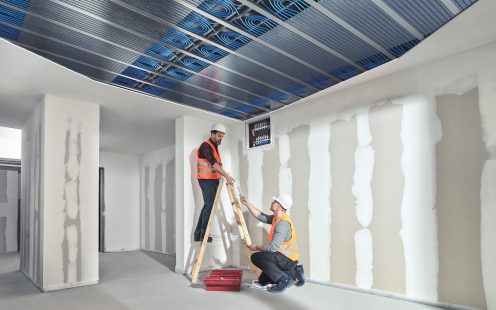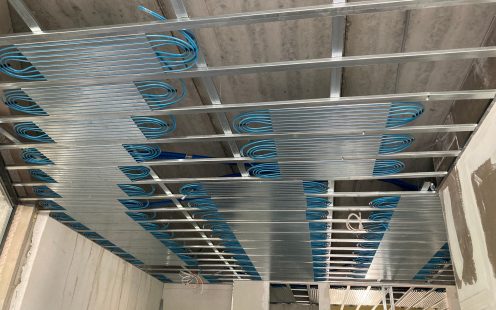21ST-CENTURY INDOOR CLIMATE CONTROL: THE ADVANTAGES OF RADIANT COOLING SYSTEMS
During the last years, Europe has seen extreme temperature increases in summer. As communities seek ways to protect themselves from heat, the demand for air conditioning units has skyrocketed, even in regions that previously did not require indoor cooling. However, the growing popularity of air conditioning systems underlines the need to reevaluate their sustainability. We talked with Ivan Milenovic, Pipelife’s expert on heating and cooling solutions, about alternatives to air conditioning and what customers should expect from 21-st century cooling solutions.

Can We Afford More Air Conditioners?
According to the International Energy Agency, air conditioners and electric fans currently account for nearly 20% of the electricity consumed in buildings worldwide. With demand for AC units growing, their energy consumption share is expected to rise even further, putting a considerable burden on the power supply infrastructure, our wallets and the environment in the next decades.
While protecting people from excessive heat is crucial, the high energy consumption and greater contribution to CO2 emissions of forced-air cooling systems have made engineers, architects and homeowners seek more sustainable alternatives.
The Dark Horse of Cooling Solutions
Nowadays, radiant heating systems are widely used due to the higher efficiency and comfort levels compared to alternatives. However, it is less known that the same technology can be used in reverse to cool indoor environments.
Radiant cooling is based on the radiation heat transfer process. It allows achieving comparably better comfort levels at less required energy. Reduced energy demands of the system not only translate into lower bills but also open more possibilities for homeowners who seek energy independence.
“Radiant cooling is a perfect solution not only for new housing development and renovation but also for the so-called passive houses or zero-energy houses,” says Ivan Milenovic, Business Development Manager at Pipelife. “The most energy-saving option to run the system would be installing a heat pump. To operate, heat pumps require nothing but electricity which can come from alternative sources.”
However, energy savings are only part of the benefits surface cooling offers. Installing cooling pipes in walls or ceilings makes the entire system invisible and inaudible. As there is no forced-air circulation, hydronic cooling systems also provide more comfort for people suffering from allergies. The whole area can be cooled evenly without unpleasant drafts or hot or cold spots.
“When there is an air conditioner on, you have lower temperatures in the direction where the air is being blown compared to the rest of the room,” explains Milenovic, “With surface cooling, distribution of the temperature inside the room is more even, and we perceive it as more comfortable.”
.jpg)
Single System for Indoor Comfort All Year Round
Another appeal of hydronic solutions is that a single system can provide both heating and cooling, ensuring optimal indoor climate in all seasons. The pipes can be installed under floors, in walls or ceiling, providing a tailored setup for each client and their specific needs.
“Humans feel more comfortable when warmer areas are closer to our feat,” comments Milenovic, “so, theoretically, the optimal way would be installing heating pipes under the floor and cooling pipes in the ceiling. However, we can also install them in the walls — in such cases, the same surface provides heating and cooling.”
By combining hydronic heating and cooling with state-of-the-art thermoregulation systems, it is possible to select different temperatures for separate zones and maintain them 24/7. In addition, modern sensors ensure that the air temperatures never drop below the dew point, preventing the risk of increased indoor humidity.
“Customers receive all necessary sensors which monitor air temperature and relative air humidity. In addition, the system registers users’ daily activities, preferences and patterns and adjusts the operation automatically. For example, it can reduce the cooling intensity when you leave your home for work and turn it back in time for your return. While users have an opportunity to control everything at a very nuanced level, the idea is that over time, they hardly have to interact with the system,” sums up Milenovic.
Simple Installation, Maintenance-Free Operation
Setting up an indoor heating and cooling system can be challenging and typically requires installation by professionals. To speed up and simplify this process, Pipelife offers prefabricated hydronic heating and cooling mats. Every system is designed, manufactured and preassembled according to each project’s specific needs, which makes the installation 4-5 times faster. Once set up, the system requires zero maintenance and lasts for the lifetime of the building.
“Each mat is assembled and checked by professionals in a controlled environment; therefore, you have a highly reliable result. Of course, installers have to roll it all out and connect to the manifold, but the process is much easier and faster,” sums up Milenovic, “We are now also offering such systems to the DIY market — following our instructions, clients can complete the installation on their own provided they have basic technical knowledge.”

Sustainability and Cost-Efficiency: Next-Generation Cooling Solutions
According to the International Energy Agency, the energy demand for cooling systems could more than triple already by 2050. Fatih Birol, the Executive Director of IEA, describes the growing demand for air conditioners as “one of the most critical blind spots in today’s energy debate” and calls for higher efficiency standards to be set for cooling systems.
Just like underfloor heating addresses the drawbacks of conventional heating solutions, hydronic cooling systems have the potential to replace air conditioning as a more ecological and economical alternative.
“15-20 years ago, there was a reluctance to install underfloor heating systems because it was something new and unknown. Nowadays, such systems are a standard solution in many countries,” points out Milenovic. “When we talk about surface cooling, there are all preconditions for this technology to become a standard solution, too.”
Find out more about our heating and cooling solutions
Get in Touch
Please choose your preferred way to get in contact with us. We will get back to you as soon as possible.
Fill our form